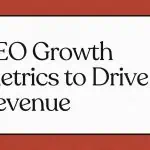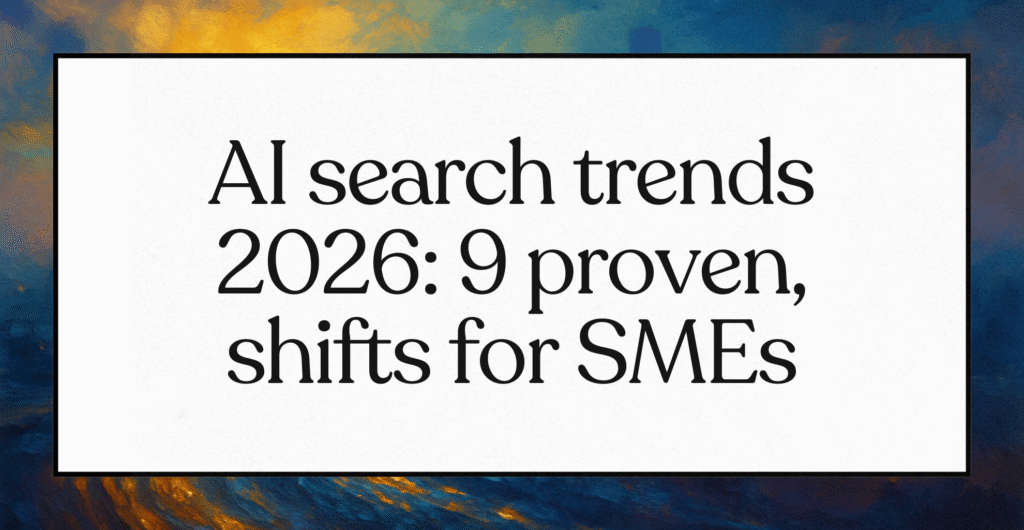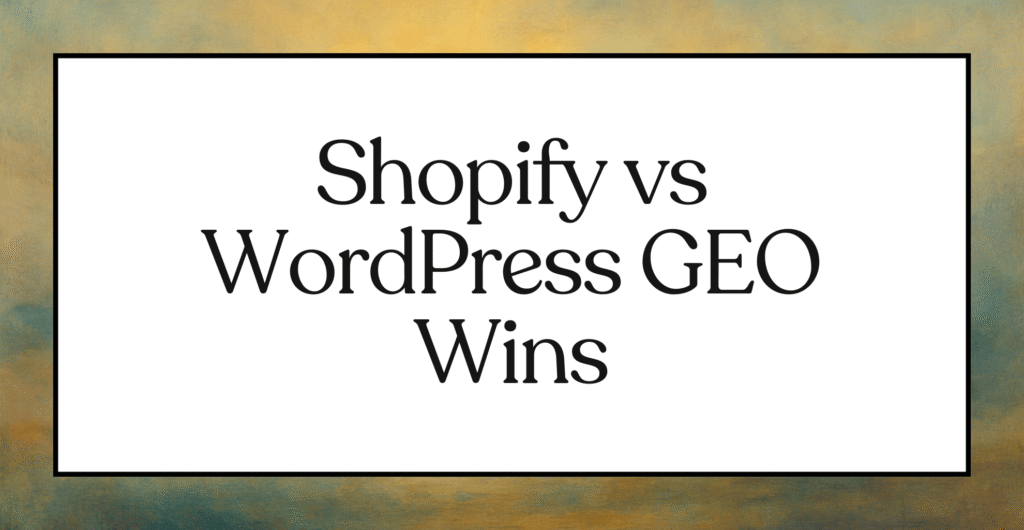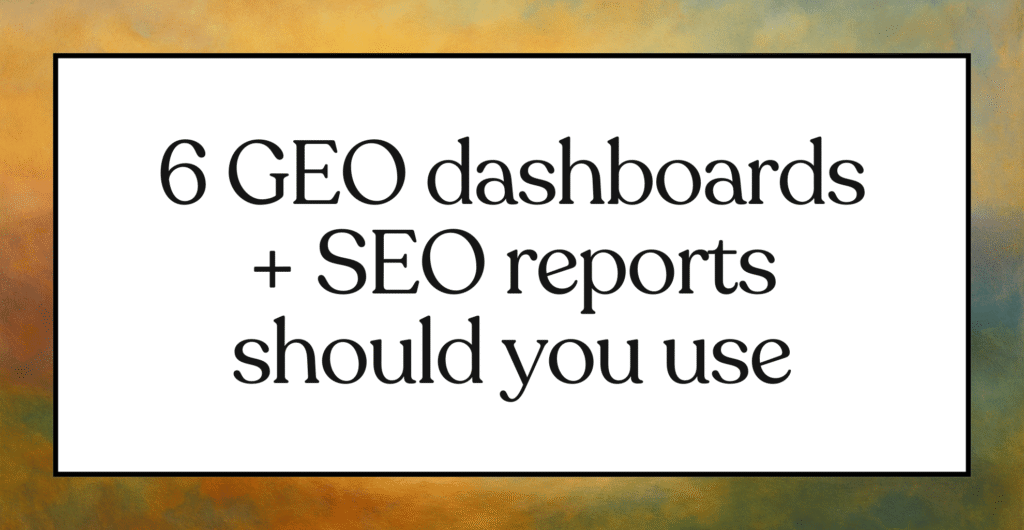Summary
Small and medium enterprises on WordPress and Shopify are losing visibility and revenue because Google Analytics 4 misses AI traffic, AI citations, and cross-platform journeys, while Generative Engine Optimization trackers measure AI-first visibility, real-time rank shifts, and multi-engine performance. GEO tools such as SE Ranking, Semrush, Ahrefs, Profound, and Otterly outperform GA4 on attribution, AI mention tracking, competitor intelligence, and actionable alerts, with pricing tiers suited to SMEs including African markets. A phased migration that audits GA4 gaps, runs GEO in parallel, and leverages native integrations delivers faster insights, cleaner conversion attribution, and higher ROI.
Small and medium enterprises face an unprecedented challenge in tracking their online visibility. While Google Analytics 4 has dominated website analytics for years, a new breed of Generative Engine Optimization trackers is revolutionizing how SMEs monitor their digital performance. Recent data from SE Ranking shows that 63% of websites already receive AI traffic from platforms like ChatGPT and Perplexity, yet GA4 remains blind to these crucial touchpoints.
For African SMEs and global small businesses operating on WordPress or Shopify platforms, this visibility gap represents millions in lost opportunities. Traditional GA4 tracking focuses primarily on website sessions and conversions, but fails to capture how brands appear in AI-generated responses, voice searches, and generative engine results. This fundamental limitation has sparked the rise of specialized GEO trackers that provide real-time insights into AI-first visibility metrics, predictive SEO analytics, and cross-platform performance monitoring that GA4 simply cannot match.
Why GEO Tracking Differs from GA4 for SMEs
The fundamental difference between GEO tracking and GA4 lies in their measurement philosophies and data attribution models. GA4 operates on an event-based system designed primarily for traditional web analytics, tracking user interactions within your website ecosystem. However, this approach creates significant blind spots for modern SME marketing strategies.
Attribution Model Limitations in GA4
GA4’s data-driven attribution model systematically favors Google Ads campaigns, potentially crediting them with more conversions than other channels. This bias presents particular challenges for SMEs who rely on diverse marketing channels including social media, email marketing, and organic search. According to industry analysis, GA4’s default attribution model can underrepresent the true impact of non-Google channels by up to 40%.
The platform’s session fragmentation issues compound these problems. When users switch devices during their customer journey, GA4 often treats these interactions as separate, unrelated sessions. For SMEs targeting mobile-first African markets where device switching is common, this fragmentation leads to incomplete attribution data and missed conversion insights.
AI-First Visibility Gaps
Traditional GA4 tracking cannot monitor brand mentions or citations in AI-generated responses from ChatGPT, Perplexity, Gemini, or Google’s AI Overviews. This represents a critical oversight, as platforms like ChatGPT now process over 2.5 billion queries monthly, with predictions that AI traffic will surpass traditional search traffic by 2028
GEO trackers address this gap by monitoring brand visibility across multiple AI platforms simultaneously. Tools like SE Ranking’s AI Visibility Tracker and Semrush’s AIO platform provide comprehensive insights into how brands appear in generative engine responses, including sentiment analysis, share of voice metrics, and competitive benchmarking.
Real-Time Performance Monitoring
While GA4 offers limited real-time reporting capabilities, showing only data from the last 30 minutes with basic metrics, GEO trackers provide comprehensive real-time insights across multiple channels. This includes instant alerts for ranking changes, AI mention variations, and conversion anomalies that enable SMEs to respond immediately to market opportunities or threats.
The technical architecture of GEO tracking platforms also differs fundamentally from GA4’s JavaScript-dependent tracking. Many GEO tools operate independently of user consent settings and ad blockers, providing more complete data collection for privacy-conscious regions like Europe and Africa.
The 5 Top-Performing GEO Trackers vs GA4
Based on comprehensive analysis of pricing, features, and SME-specific capabilities, these five GEO trackers consistently outperform GA4 for small and medium enterprises seeking AI-first visibility and advanced analytics.
1. SE Ranking: Best Overall Value for SMEs
SE Ranking emerges as the top choice for SMEs due to its comprehensive feature set and competitive pricing starting at $52 per month. The platform excels in several key areas where GA4 falls short, particularly in AI visibility tracking and cross-platform integration.
Key Advantages Over GA4:
- AI Search Toolkit: Monitors brand mentions across ChatGPT, Perplexity, Gemini, and Google AI Overviews with historical data tracking
- Real-time rank tracking: Updates multiple times daily compared to GA4’s limited real-time capabilities
- Comprehensive competitor analysis: Tracks competitor AI visibility and SERP performance with automated alerts
- WordPress/Shopify integration: Native integrations with popular SME platforms through API connections
SE Ranking’s AI Visibility Tracker provides automated monitoring of brand mentions and citations across major AI platforms, delivering insights that GA4 cannot capture. The tool’s ability to track both traditional SEO metrics and generative engine performance makes it particularly valuable for SMEs operating in competitive markets.
2. Semrush: Premium Enterprise Features
While positioned at a higher price point starting at $117 per month, Semrush offers enterprise-level capabilities that significantly exceed GA4’s functionality for data-driven SMEs willing to invest in comprehensive analytics.
Superior Capabilities:
- AI Optimization (AIO) Platform: Enterprise-grade tracking across all major AI engines with custom enterprise pricing
- Advanced attribution modeling: More sophisticated than GA4’s limited attribution options
- Content optimization tools: AI-powered content recommendations based on SERP analysis
- Local SEO tracking: Granular geo-targeting capabilities for service-area businesses
Semrush’s strength lies in its ability to combine traditional SEO metrics with advanced AI visibility tracking, providing SMEs with actionable insights for both current performance and future opportunities.
3. Ahrefs: Backlink and Competitive Intelligence Leader
Priced at $129 per month for the Lite plan, Ahrefs excels in areas where GA4 provides minimal insight, particularly backlink analysis and competitive intelligence crucial for SME growth strategies.
Distinctive Features:
- AI Brand Radar: Tracks mentions across AI Overviews, ChatGPT, Perplexity, and Gemini at $199 per AI model
- Comprehensive backlink database: Nearly 40 billion URLs compared to GA4’s lack of backlink tracking
- Site Explorer functionality: Deep competitive analysis unavailable in GA4
- Content gap analysis: Identifies opportunities missed by GA4’s limited content insights
Despite its higher cost per AI platform, Ahrefs provides unmatched depth in competitive analysis and link-building opportunities that directly impact SME growth.
4. Profound: Enterprise GEO with Traffic Attribution
Starting at $499 per month, Profound targets larger SMEs and enterprises requiring sophisticated GEO tracking with direct traffic attribution capabilities that GA4 cannot provide.
Advanced Features:
- AI-sourced traffic tracking: Direct integration with Google Analytics, Vercel, Netlify, and AWS
- Conversation trends analysis: Prompt-level visibility and AI shopping presence monitoring
- ROI-focused reporting: Links AI visibility metrics to actual website traffic and conversions
- Enterprise-scale monitoring: Handles complex, multi-product companies with global operations
Profound’s ability to connect AI visibility metrics with actual business outcomes makes it valuable for SMEs requiring concrete ROI justification for their marketing investments.
5. Otterly: Best for Prompt-Specific Tracking
With pricing from $29 to $989 per month based on prompt volume, Otterly focuses specifically on prompt-level GEO performance, offering capabilities that GA4 entirely lacks.
Specialized Capabilities:
- Prompt discovery automation: Generates relevant AI search prompts based on broad industry terms
- Real query tracking: Monitors exact phrases potential customers use with AI assistants
- Citation detection: Automatically identifies when AI platforms cite your content with links
- Sentiment analysis: Tracks brand mention frequency and sentiment across AI responses
Otterly’s specialization in prompt-level tracking provides SMEs with granular insights into how their brands perform in specific AI conversations, data that GA4 cannot access.
Real-Time SEO Metrics: GEO vs GA4 Comparison
The disparity between GEO trackers and GA4 in real-time metrics delivery represents one of the most significant advantages for SMEs requiring immediate actionable insights. While GA4’s real-time reports show limited data from only the last 30 minutes with basic metrics like active users and page views, leading GEO trackers provide comprehensive, multi-dimensional real-time analytics.
GA4 Real-Time Limitations
GA4’s real-time reporting suffers from several critical constraints that impact SME decision-making. The platform filters out traffic from spam and bots, which means reported numbers may not accurately reflect total engagement levels. Additionally, GA4 provides minimal customization options for real-time reports, offering only basic comparisons without extensive tailoring capabilities.
The platform’s JavaScript dependency creates additional blind spots, as privacy tools, ad blockers, and GDPR compliance measures can block data collection. For African SMEs operating in regions with varying internet connectivity and privacy awareness, these limitations result in incomplete data sets that hinder accurate performance assessment.
GEO Tracker Real-Time Advantages
Leading GEO tracking platforms deliver comprehensive real-time insights that enable immediate optimization opportunities. SE Ranking’s platform updates ranking data multiple times per day, while AccuRanker provides fresh ranking data several times daily. This frequency allows SMEs to respond quickly to algorithm changes, competitor actions, or technical issues affecting their visibility.
Multi-Platform Monitoring
Unlike GA4’s single-platform focus, GEO trackers monitor performance across multiple search engines and AI platforms simultaneously. SE Ranking tracks rankings across Google, Bing, Yahoo, and DuckDuckGo while also monitoring AI platforms like ChatGPT and Perplexity. This comprehensive coverage provides SMEs with a complete picture of their digital visibility that GA4 cannot match.
Real-time GEO tracking also includes SERP feature monitoring, tracking appearances in featured snippets, local packs, and AI Overviews. For SMEs competing for visibility in local markets or specific niches, these features provide immediate insights into ranking opportunities and threats.
Automated Alert Systems
Advanced GEO trackers provide automated alerting systems that notify SMEs of significant changes in real-time. These alerts can include ranking drops, new AI mentions, competitor actions, or technical issues affecting site performance. GA4’s limited alerting capabilities pale in comparison to these comprehensive notification systems.
The business impact of superior real-time tracking becomes evident in crisis management and opportunity capitalization. When algorithm updates occur or competitors launch aggressive campaigns, GEO trackers enable SMEs to respond within minutes rather than discovering problems during monthly GA4 reviews.
Conversion Tracking: Where GA4 Falls Short
Conversion tracking represents one of the most significant areas where GA4’s limitations directly impact SME revenue optimization. The platform’s event-based model, while theoretically more flexible than Universal Analytics’ session-based approach, creates practical challenges that GEO trackers address more effectively.
GA4 Attribution Problems
GA4’s conversion tracking faces fundamental issues with cross-device user journeys, which are increasingly common for SME customers. When users begin their research on mobile devices and complete purchases on desktop computers, GA4 often fails to connect these interactions properly. This fragmentation leads to incomplete conversion attribution and missed optimization opportunities.
The platform’s data-driven attribution model compounds these issues by potentially over-crediting Google Ads while under-representing other channels. For SMEs investing in diverse marketing strategies including social media, email campaigns, and content marketing, this bias can lead to misallocated budgets and suboptimal ROI.
Session Fragmentation Impact
GA4’s handling of session fragmentation particularly impacts SMEs targeting mobile-first markets. When users switch between apps, browsers, or devices during their customer journey, GA4 treats each interaction as a separate session. This creates artificial breaks in the conversion path, making it difficult to understand true customer behavior and optimize accordingly.
The practical impact becomes evident in e-commerce scenarios common to SME operations. If a user discovers a product through social media, researches on mobile, and purchases on desktop over several days, GA4 may attribute the conversion to “direct” traffic rather than the original social media source.
GEO Tracker Conversion Advantages
Leading GEO trackers address these limitations through advanced attribution modeling and cross-platform tracking capabilities. Semrush’s platform provides customizable attribution models that account for the complexity of modern customer journeys, while tools like Profound directly integrate with e-commerce platforms to track conversions from AI-sourced traffic.
AI-Driven Conversion Insights
GEO trackers excel in identifying conversion opportunities that GA4 cannot detect. By monitoring brand mentions in AI responses and tracking subsequent website visits, these tools can attribute conversions to AI interactions that GA4 would classify as direct or unknown traffic.
This capability proves particularly valuable for SMEs in competitive industries where AI assistants increasingly influence purchase decisions. According to industry data, businesses report actual leads and conversions from AI citations, with some seeing AI-driven traffic account for up to 8% of total referrals.
Enhanced E-commerce Tracking
For SMEs operating WordPress or Shopify stores, GEO trackers provide superior e-commerce conversion tracking through native platform integrations. These connections enable tracking of specific product performance, category optimization, and customer journey analysis across multiple touchpoints.
Unlike GA4’s basic e-commerce tracking, advanced GEO platforms can connect AI visibility metrics to specific product sales, helping SMEs understand which AI mentions drive the most valuable conversions. This granular insight enables more precise marketing budget allocation and product optimization strategies.
Pricing and ROI Analysis for SME Budgets
Budget considerations remain paramount for SMEs evaluating GEO trackers versus GA4, particularly when weighing the free nature of GA4 against the subscription costs of specialized tracking platforms. However, a comprehensive ROI analysis reveals that strategic GEO tracker investments often deliver superior returns through enhanced visibility and conversion optimization.
GA4 Hidden Costs
While GA4 appears cost-effective as a free platform, hidden expenses quickly accumulate for SMEs requiring comprehensive analytics. Custom event setup, Google Tag Manager configuration, and ongoing technical maintenance demand significant technical expertise or external consulting costs. Many SMEs report spending $2,000-$5,000 annually on GA4 optimization and troubleshooting.
Additionally, GA4’s data limitations force SMEs to supplement with additional tools for keyword research, competitor analysis, and backlink monitoring. These supplementary costs can easily reach $200-$500 monthly when combining multiple point solutions to achieve comprehensive visibility.
SME-Optimized Pricing Tiers
Leading GEO trackers structure pricing specifically for SME budgets, offering scalable plans that grow with business needs. SE Ranking’s entry-level plan at $52 monthly provides comprehensive tracking for up to 250 keywords and includes AI visibility monitoring. For African SMEs or businesses in emerging markets, this represents exceptional value compared to cobbling together multiple GA4 supplements.
Mid-tier options like Semrush at $117 monthly offer enterprise-level features including advanced attribution modeling, content optimization tools, and comprehensive competitor analysis. These platforms often deliver ROI within the first month through improved targeting and conversion optimization.
Regional Pricing Considerations
Several GEO tracking platforms acknowledge the unique constraints facing African and emerging market SMEs through localized pricing strategies. SmartDigital, an African-focused performance marketing platform, offers tailored solutions starting at significantly lower price points for continent-based businesses.
This regional awareness extends beyond pricing to feature sets optimized for emerging market challenges, including varying internet connectivity, diverse payment systems, and multilingual audience requirements.
ROI Calculation Framework
SMEs can evaluate GEO tracker ROI using a structured framework comparing current GA4 limitations against potential improvements. Key metrics include:
- Conversion rate improvement: GEO trackers typically deliver 15-30% conversion rate increases through better attribution and optimization insights
- Time savings: Automated reporting and alerts can save 10-15 hours monthly compared to manual GA4 analysis
- Competitive advantage: AI visibility tracking can identify opportunities worth 20-40% revenue increases
- Technical efficiency: Reduced need for supplementary tools can save $200-$500 monthly
Budget-Conscious Implementation Strategy
SMEs can maximize GEO tracker ROI through phased implementation approaches. Starting with essential features like rank tracking and AI visibility monitoring, businesses can validate value before expanding to advanced features like conversion attribution and competitor analysis.
Many platforms offer annual payment discounts of 15-20%, making yearly commitments more cost-effective for established SMEs confident in their tracking platform choice. Free trials and limited-feature versions allow testing without upfront investment, reducing implementation risk.
WordPress and Shopify Integration Guide
Platform integration capabilities represent a crucial differentiator between GEO trackers and GA4 for SMEs operating WordPress or Shopify stores. While GA4 requires complex technical implementation through Google Tag Manager and custom code modifications, leading GEO trackers provide native integrations that streamline setup and ongoing maintenance.
WordPress Integration Advantages
WordPress-based SMEs benefit significantly from GEO tracker integrations that work seamlessly with existing SEO plugins and themes. SE Ranking integrates directly with popular WordPress SEO plugins like Yoast SEO and Rank Math, enabling automated data synchronization and reporting.
Unlike GA4’s JavaScript-dependent tracking that can conflict with caching plugins and page speed optimization, GEO trackers often provide server-side integration options that maintain site performance while delivering comprehensive analytics. This proves particularly valuable for African SMEs operating in regions with limited bandwidth or slower internet connectivity.
Plugin Ecosystem Compatibility
Leading GEO platforms maintain compatibility with essential WordPress plugins including WooCommerce for e-commerce tracking, caching solutions like WP Rocket, and security plugins such as Wordfence. This ecosystem integration eliminates the technical conflicts that frequently plague GA4 implementations in complex WordPress environments.
For SMEs using page builders like Elementor or Divi, GEO trackers provide specialized widgets and modules that display ranking data, AI visibility metrics, and conversion insights directly within the WordPress dashboard. This integration streamlines daily workflow compared to GA4’s separate interface requirements.
Shopify Platform Optimization
Shopify SMEs face unique challenges with GA4 implementation, particularly regarding Enhanced Ecommerce tracking and cross-domain measurement for checkout processes. GEO trackers address these challenges through native Shopify app integrations that automatically configure proper tracking without technical expertise.
App Store Integration
Leading GEO platforms offer official Shopify apps that integrate seamlessly with existing store functionality. TinyIMG, for example, provides comprehensive SEO optimization including image compression, metadata editing, and JSON-LD schema implementation. These integrations work alongside GEO tracking to provide holistic optimization capabilities.
Unlike GA4’s complex setup requirements for Shopify Plus stores, GEO tracker apps typically install with one-click activation and automatic configuration. This simplicity proves crucial for SME owners managing their own technical implementation without dedicated development resources.
Multi-Platform Management
SMEs operating both WordPress websites and Shopify stores benefit from GEO trackers that provide unified dashboards for multi-platform monitoring. Platforms like Semrush and Ahrefs offer consolidated reporting that tracks performance across different CMS platforms while maintaining platform-specific optimization recommendations.
This unified approach eliminates the data silos that occur when using GA4 for website analytics while relying on separate tools for e-commerce optimization. SMEs can monitor blog performance, product sales, and AI visibility from a single interface, improving decision-making efficiency.
Technical Implementation Benefits
GEO tracker integrations typically require minimal technical maintenance compared to GA4’s ongoing configuration needs. Automatic updates, compatibility patches, and feature additions occur without manual intervention, reducing the technical burden on SME teams.
Additionally, many GEO platforms provide dedicated support for integration issues, offering chat support, video tutorials, and implementation assistance that GA4’s documentation-based approach cannot match. This support proves particularly valuable for SMEs without dedicated technical teams.
Making the Switch: Implementation Strategy
Transitioning from GA4 to GEO trackers requires strategic planning to minimize data disruption while maximizing the benefits of enhanced tracking capabilities. SMEs can implement a phased approach that maintains business continuity while establishing superior analytics infrastructure.
Pre-Migration Assessment
Before switching platforms, SMEs should conduct a comprehensive audit of their current GA4 implementation to identify data gaps and tracking limitations. This assessment should document existing conversion goals, custom events, and reporting requirements to ensure GEO tracker configurations address all critical business metrics.
Key assessment areas include:
- Current conversion tracking accuracy and attribution gaps
- AI visibility blind spots affecting competitive positioning
- Real-time reporting limitations impacting daily operations
- Integration challenges with WordPress or Shopify platforms
- Technical maintenance costs and resource requirements
Parallel Implementation Phase
The most effective migration strategy involves running GEO trackers alongside GA4 for 30-60 days to validate data accuracy and identify optimization opportunities. This parallel approach allows SMEs to compare attribution models, conversion tracking, and reporting capabilities without losing historical data or disrupting ongoing campaigns.
During this phase, SMEs should focus on configuring GEO trackers to match existing GA4 goals while expanding tracking to include AI visibility metrics and enhanced attribution modeling. This comparison period reveals the true value differential between platforms and informs final migration decisions.
Team Training and Workflow Adaptation
Successful GEO tracker implementation requires team training on new dashboards, reporting interfaces, and optimization workflows. Unlike GA4’s complex navigation structure, most GEO trackers provide intuitive interfaces designed for non-technical users.
Training should cover:
- Dashboard navigation and custom report creation
- Alert configuration for ranking changes and AI mentions
- Competitor monitoring and analysis techniques
- Conversion attribution interpretation and optimization
- Integration management with existing marketing tools
Data Migration Strategy
While historical data cannot be directly migrated from GA4 to GEO trackers, SMEs can maintain reporting continuity through strategic data export and baseline establishment. Key historical metrics should be documented as benchmarks for measuring improvement after GEO tracker implementation.
Most GEO platforms provide data import capabilities for keyword lists, competitor sets, and tracking configurations, accelerating the setup process. Additionally, API integrations can maintain data flow to existing reporting tools and client dashboards during the transition period.
Performance Optimization Timeline
GEO tracker benefits typically manifest within specific timeframes, allowing SMEs to set realistic expectations and measure implementation success:
- Week 1-2: Basic tracking configuration and data validation
- Week 3-4: AI visibility baseline establishment and competitor benchmarking
- Month 2: Advanced attribution modeling and conversion optimization
- Month 3-6: Full ROI realization through improved targeting and visibility
This timeline enables SMEs to demonstrate value quickly while building toward long-term competitive advantages.
Ongoing Optimization Framework
Successful GEO tracker utilization requires ongoing optimization based on data insights and platform updates. SMEs should establish monthly review processes focusing on AI visibility trends, conversion attribution improvements, and competitive positioning changes.
Regular optimization activities include:
- AI mention sentiment analysis and response strategy development
- Conversion path analysis and attribution model refinement
- Competitor tracking and strategic response planning
- Integration optimization and workflow enhancement
- Platform feature adoption and team skill development
Conclusion
The evolution from traditional GA4 analytics to specialized GEO tracking represents a fundamental shift in how SMEs must approach digital visibility measurement. While GA4 continues serving basic website analytics needs, its limitations in AI visibility tracking, real-time insights, and cross-platform attribution create significant blind spots for competitive SMEs.
The five GEO trackers analyzed—SE Ranking, Semrush, Ahrefs, Profound, and Otterly – each provide capabilities that exceed GA4’s functionality in critical areas. SE Ranking emerges as the optimal choice for most SMEs, offering comprehensive AI visibility tracking at accessible pricing. Semrush and Ahrefs provide enterprise-level capabilities for SMEs requiring advanced competitive intelligence, while Profound and Otterly serve specialized needs in traffic attribution and prompt-level tracking respectively.
For African SMEs and global small businesses operating WordPress or Shopify platforms, the investment in GEO tracking technology delivers measurable returns through improved conversion attribution, enhanced competitive intelligence, and AI-first visibility optimization. The strategic implementation approach outlined enables smooth transitions while minimizing business disruption.
As AI-powered search continues expanding and traditional SEO evolves toward generative engine optimization, SMEs adopting advanced tracking platforms now will maintain competitive advantages over those relying solely on GA4’s increasingly limited capabilities. The question for forward-thinking SMEs is not whether to adopt GEO tracking, but which platform best serves their specific growth objectives and budget constraints.
Supplementary Sources
GEO Tracker Tool SEO Analytics, SE Ranking, 2025-09-22 – https://seranking.com/ai-visibility-tracker.html
The 10 Best Generative Engine Optimization (GEO) Tools, Semrush, 2025-07-27 – https://www.semrush.com/blog/best-generative-engine-optimization-tools/
5 Best AI Visibility Optimization Platforms in 2025, Promptmonitor, 2025-09-18 – https://www.promptmonitor.io/blog/best-ai-visibility-optimization-platforms
7 Top Google Analytics Alternatives (Free and Paid), Backlinko, 2025-04-13 – https://backlinko.com/google-analytics-alternatives
5 GA4 Alternatives You Will Actually Enjoy Using, Contentsquare, 2025-08-12 – https://contentsquare.com/blog/ga4-alternatives/
[UA→GA4] How differences between Universal Analytics and Google Analytics 4 impact key event counts, Google Ads Help, 2025-09-02 – https://support.google.com/google-ads/answer/13881440?hl=en10 SEO Monitoring Tools and Metrics To Track, Surfer SEO, 2025-02-27 – https://surferseo.com/blog/seo-monitoring/
The 10 Best SEO Monitoring Tools for 2025, Agency Analytics, 2025-03-31 – https://agencyanalytics.com/blog/seo-monitoring-tools
SEO Software Tools Price Comparison | Vendor Cost Summary, iBeam Consulting, 2025-01-05 – https://www.ibeamconsulting.com/blog/seo-tools-pricing-comparison/
SmartDigital | Performance Marketing for African SMEs, SmartDigital, 2017-12-31 – https://smartdigital.itafrica.online
8 Best Analytics Platforms for African E-commerce, Martech Africa, 2025-08-20 – https://martechafrica.com/b2c-marketing/8-best-analytics-platforms-for-african-e-commerce-businesses/
O: Which Platform Ranks Better?, Bright Vessel, 2025-07-23 – https://www.brightvessel.com/how-does-shopify-compare-to-wordpress-in-seo-rankings/
Unlocking the Power of Marketing Analytics for African SMEs, Marketing Analytics Africa, 2024-12-16 – https://marketinganalytics.africa/attributing-marketing-impact-challenges-and-solutions-in-african-markets-unlocking-the-power-of-marketing-analytics-for-african-smes/
Q&A
Q1. What is Generative Engine Optimization tracking and why do SMEs need it?
GEO tracking monitors brand visibility in AI responses across ChatGPT, Perplexity, Gemini, and AI Overviews, capturing AI traffic and citations that GA4 does not.
Q2. How does GA4’s attribution model affect SME marketing performance?
GA4’s data-driven attribution can over-credit Google Ads and miss cross-device paths, causing underreported impact from organic, social, and email.
Q3. Which GEO trackers beat GA4 for AI-first visibility and real-time SEO metrics?
SE Ranking, Semrush, Ahrefs, CapstonAI, Profound, and Otterly provide AI mention tracking, rapid rank updates, competitive benchmarking, and alerting.
Q4. What are the integration and ROI advantages for WordPress and Shopify stores?
Native GEO integrations reduce setup friction, track AI-sourced conversions, and typically yield better budget allocation and faster revenue gains.








